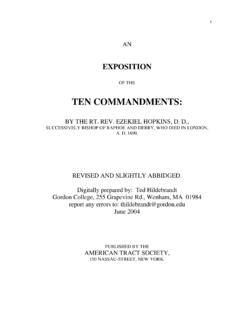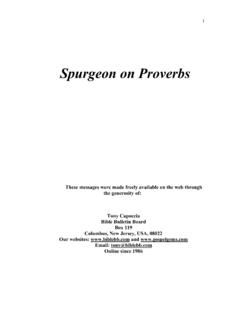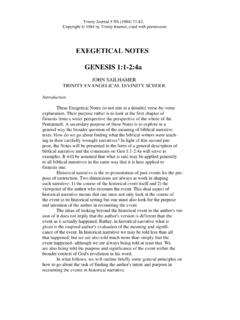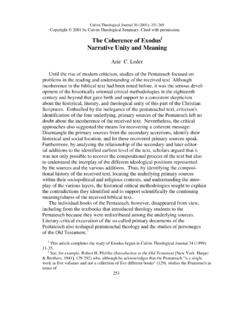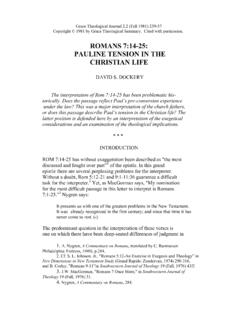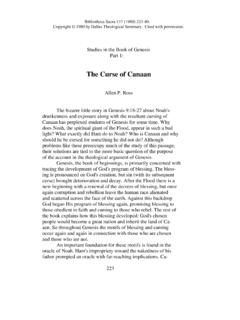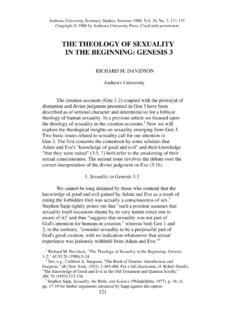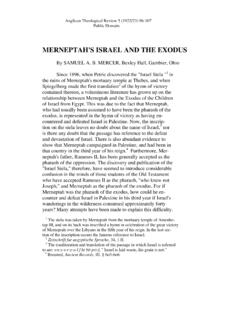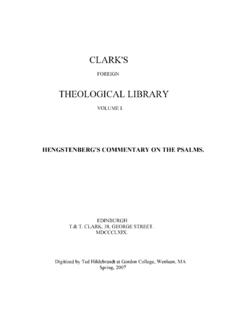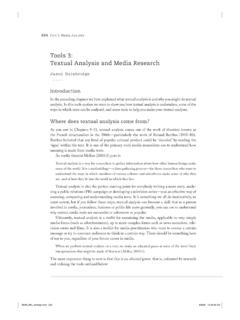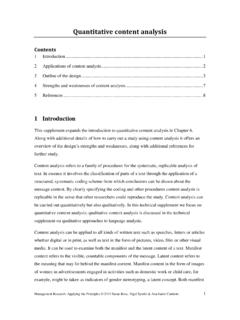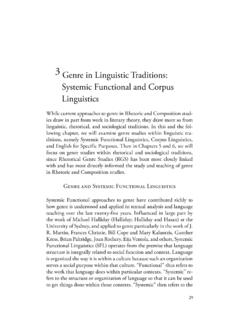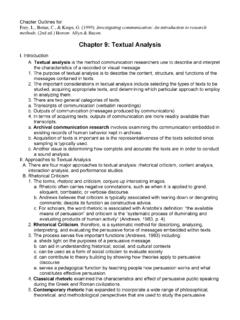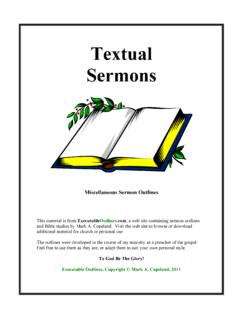Transcription of The Waters of the Earth: An Exegetical Study of Psalm 104:1-9
1 Grace Theological Journal (1986) 57-80 [Cited with permission from Grace Theological Seminary; digitally prepared for use at Gordon and Grace Colleges and elsewhere] THE Waters OF THE EARTH: AN Exegetical Study OF Psalm 104:1-9 DAVID G. BARKER Ps 104:6-9 is viewed as a reference to the flood of Noah, not the original creation week. Support for this interpretation is drawn from broad studies in the Psalm s setting, literary structure, and grammar. Current literature on the Psalm is brought into the discussion. The conclusion is drawn that the Psalm displays a unique cosmology and a perspective including not only Yahweh s creative power, but also Yahweh s providential control in judgment and blessing. More specifi- cally, Ps 104:8a speaks of the catastrophic tectonic activities associated with the Genesis flood. * * * INTRODUCTION Psalm 104 is a majestic hymn of praise which extols Yahweh as creator and sustainer of the natural world.
2 As a companion hymn to Psalm 103, it calls upon the individual worshiper to add his voice to the vast chorus of praise ascending to the very heavenly dwelling place of God. The specific issue for discussion in this Study is the meaning of vv 6-9. Most would argue that the Psalm reflects the six day creation week of Genesis 1, and that the specific reference in Ps 104:6-9 is to the events of the first two days of the week which culminate in Gen 1:9. However, others have suggested that the Noahic flood is in view, here, and that the Psalm goes far beyond the limits of Genesis 1. Additionally, a specific problem is encountered in the translation and interpretation of v 8a of the Psalm . What is going up and down? Is it the Waters or the mountains? If the former is accepted, both textual and imagery problems develop; if the latter, contextual prob- lems arise. The purpose of this article, therefore, is to determine if it is a viable alternative to interpret Ps 104:6-9 as a reference to the Noahic deluge.
3 Additionally, it will seek to determine the best translation of v 8a in light of syntax, imagery and context. A more general purpose 58 GRACE THEOLOGICAL JOURNAL of this Study , however, is to exegete Ps 104:1-9 taking into considera- tion factors such as structure, setting, and literary history. Essential to ascertaining the proper interpretation of Ps 104:6-9 is a broad analysis of the Psalm in terms of its form, its setting in Israel's liturgy, and its literary relationships with similar ancient Near Eastern hymns. The first section of this Study covers these areas. In particular, of great significance is the analysis of the Psalm to deter- mine if, in fact, the six day creation week forms the organizational skeleton, or if there are other structural analyses that would see the Psalm in a broader perspective. Then the second section supplies an exegesis of vv 1-9 which is built upon the backgrounds and structural framework determined in the first section.
4 The first five verses are included in this Study in order to provide a preparatory textual analysis for the treatment of vv 6-9. It is shown that vv 5-13 form an independent stanza of the Psalm , with two subunits comprised of vv 5-9 and 10-13 respectively. Therefore, for the sake of completeness, vv 10-13 and their relation- ship to the previous subunit are summarized. The critical text for analysis is vv 6-9. Therefore, while the Psalm is analyzed in its entirety for the purpose of ascertaining structure, the Study basically limits itself to the first nine verses. While a thorough analysis of the entire Psalm would obviously be profitable, a satisfactory solution to the problems noted above may be determined within the parameters out- lined for this Study . THE SETTING OF Psalm 104 Several considerations must be taken into account when a Study of the setting of Psalm 104 is undertaken. These may be enumerated as follows: (1) the question of the place of the Psalm in the liturgy of Israel, (2) its literary relationship to other similar ancient Near Eastern hymns, (3) its literary relationship to the Genesis account of creation, and (4) an analysis of the structure of the Psalm itself.
5 The Psalm in Israel's Liturgy Allen argues that on the basis of the initial and final self exhorta- tion, as well as the personal references in vv 33-34, the Psalm can be characterized as an "individual hymn."l However, it has usually been assigned a role in the corporate worship of Israel as a self exhortation to praise which in turn was to inspire communal Several l Leslie K. Allen, Psalms 101-150, in Word Biblical Commentary, ed. David A. Hubbard, et al. (Waco, TX: Word, 1983) 28. 2 Ibid. BARKER: THE Waters OF THE EARTH 59 have attempted to identify a specific setting for the Psalm . Humbert links the Psalm with some kind of Israelite autumn festival parallel with the Babylonian New Year Festival,3 though his position has not been widely Craigie argues for the setting of the dedication of Solomon's He maintains that the Psalm is firmly within the indigenous Hebrew poetic tradition, and that a reconstruction of 1 Kgs 8:12-13 based on the LXX reflects the imagery of Psalm The first two lines of the Kings passage as reconstructed are viewed as reflecting Egyptian and Mesopotamian sun hymns7 with a polemic intent.
6 Additionally, he believes that the last two lines reflect the adaptation of a Ugaritic Baal myth with, however, a retention of the distinctive Hebrew theology concerning the temple as a dwelling place for Yahweh. These same motifs are evident in Psalm 104; hence, its association with Solomon's temple Nevertheless, the evidence both for the reconstruction of the Kings text and the associa- tion of Psalm 104 with Solomon's Temple dedication is rather tenu- ous. Certainly, there is nothing that militates against an early date for the Psalm , but the attempt to be this precise is somewhat precarious. Crusemann has contended for a late date and non-cultic setting for the Psalm based on the mixed nature of the form of the hymn (plural summons, self exhortation, etc.).9 However, several lines of evidence have been forwarded which favor a pre-exilic date. These include the preterite use of the imperfect, the use of Oty;ha in vv 11 and 20, and perhaps the usage of hz, as a relative pronoun in vv 8 and 26 (cf.)
7 Rw,xE in vv 16, 17).10 It should be noted that Psalm 103 opens and closes in the same way as Psalm 104 and is attributed to David. Psalm 104 is untitled except in the LXX which attributes it to David, and claims have been made that the LXX should be accepted because of the com- mon opening and closing invocations. However, the common struc- ture is reason enough to explain their juxtaposition in the psalter and 3 P. Humbert, "La relation de Genese et du Psaume 104 avec la liturgie du Nouvel- An israelite," RHPR 15 (1935) 22-27. 4 See in particular A. van der Voort, "Genese 1:1a 2:4a et Psaume 104," RB 58 (1951) 343-45. 5 Peter C. Craigie, "The Comparison of Hebrew Poetry: Psalm 104 in Light of Egyptian and Ugaritic Poetry," Semitics 4 (1974) 19. 6 Ibid., 10, 19. 7 For examples of such hymns, see the "Hymn to Aton" (ANET, 369-71) and the "Shamash Hymn" (ANET, 389-90). 8 Craigie, "Comparison," 10, 19. 9 F. Crusemann, Studien zur Formgeschichte von Hymnus and Danklied in Israel (WMANT 32; Neukirchen-Vluyn: Neukirchener, 1969) 301-2.
8 10 Cf. D. A. Robertson, Linguistic Evidence in Dating Early Hebrew Poetry (SBLDS 3; Missoula: Scholars, 1972) 42-43, 54, 63, 77; cf. Allen, Psalms, 29. 60 GRACE THEOLOGICAL JOURNAL common authorship is in no way Thus, the hymn seems to have been a companion hymn to Psalm 103 which then may very well place it into the Davidic liturgical setting. The Psalm in Relation to ANE Hymnology Recent scholarship has stressed the resemblances between this Psalm and Ahkenaton's Hymn to the Sun (14th C. ).12 The refer- ences to lions creeping about at night (vv 20-21; cf. lines 17-20), man's daytime activities (vv 22-23; cf. lines 27-29), the contentment of animals and birds (vv 11-14; cf. lines 30-36), activities of creatures and ships of the sea (vv 25-26; cf. lines 37-40), the adulation of the creator by creation (v 24; cf. lines 58-60), the dependence of man upon God (v 27; cf. lines 66-67), Waters and mountains (vv 6, 10; cf. lines 66-67), and finally the life giving character of the divine being (vv 29-30; cf.)
9 Lines 108-9),13 all seem to indicate some kind of literary relationship. Some have tried to prove a direct relationship between Akhena- ton's hymn and the Breasted states, "The hymn of Ikhnaton thus reveals to us the source of the Hebrew Psalmist's recognition of the gracious goodness of God in the maintenance of his creatures, even the most insignificant."15 While most commentators stress some kind of relationship, cau- tion is usually expressed. Dahood and others posit a Canaanite mediation of the It is postulated that the Phoenicians, because of their close commercial and cultural contact with Egypt, brought the hymn into their own literary history, and that the Hebrews obtained it from the Bernhardt argues, on the basis of both theological and cosmological differences, that the relationship is quite general. He maintains that there was a similar literary Gattung in ancient Egypt and that it is not necessary to suggest that the psalmist 11 Allen, Psalms, 26.
10 12 ANET, 369-71. 13 Cf. ibid., 370-71; also Allen, Psalms, 29. 14 Crusemann, Studien, 287; James Breasted, The Dawn of Conscience (New York: Charles Scribners', 1933), 366-70; A. Weigall, The Life and Times of Akhnaton. Pharaoh of Egypt (revised; London: Butterworth, 1922), 134-36. 15 Breasted, The Dawn of Conscience, 368. 16 M. Dahood, Psalms III, 101-150 (AB; Garden City, NY: Doubleday, 1970) 33; cf. Georges Nagel, "A propos des rapports du psaume 104 avec les textes egyptiens," Festschriftfur Alfred Bertholet, ed. O. Eissfeldt, et al. (Tubingen: J. C. B. Mohr, 1950) 395-403; Kraus, Psalmen (BKAT 15 ; Ausgabe, Neukirchen-Vluyn: Neu- kirchener, 1978) 880; and Pierre Auffert, "Note sur la structure litteraire du Psaume 104 et ses incidences pour une comparison avec l' Hymne a Aton et Gen 1," RSR (1982) 73-82. 17 Dahood, Psalms III, 33. BARKER: THE Waters OF THE EARTH 61 had a specific knowledge of the Egyptian Craigie argues from a similar angle, maintaining that common motifs, subject matter, and intent will naturally result in similar As noted previously, he finds parallels in other Egyptian sun hymns, a Mesopotamian hymn to Shamash, and in particular, the Ugaritic Baal However, he maintains that this may well indicate an association of ideas rather than a literary Craigie's thesis, particularly concerning the Ugaritic Baal myth, is built heavily upon the reconstruction of the 1 Kgs 8:12-13 text, and upon the fact that Phoenician craftsmen were used in the construction of the temple.
